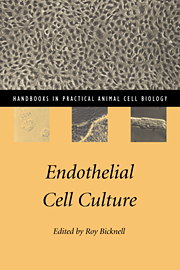Book contents
- Frontmatter
- Contents
- List of Contributors
- Preface to the series
- Acknowledgement
- 1 Introduction to the endothelial cell
- 2 Lung microvascular endothelial cells: defining in vitro models
- 3 Bone marrow endothelium
- 4 Endothelium of the brain
- 5 Isolation, culture and properties of microvessel endothelium from human breast adipose tissue
- 6 Human skin microvascular endothelial cells
- 7 Microvascular endothelium from adipose tissue
- 8 Endothelium of the female reproductive system
- 9 Synovial microvascular endothelial cell isolation and culture
- Index
9 - Synovial microvascular endothelial cell isolation and culture
Published online by Cambridge University Press: 03 November 2009
- Frontmatter
- Contents
- List of Contributors
- Preface to the series
- Acknowledgement
- 1 Introduction to the endothelial cell
- 2 Lung microvascular endothelial cells: defining in vitro models
- 3 Bone marrow endothelium
- 4 Endothelium of the brain
- 5 Isolation, culture and properties of microvessel endothelium from human breast adipose tissue
- 6 Human skin microvascular endothelial cells
- 7 Microvascular endothelium from adipose tissue
- 8 Endothelium of the female reproductive system
- 9 Synovial microvascular endothelial cell isolation and culture
- Index
Summary
Introduction
Contrary to popular belief the first attempts to culture endothelial cells in vitro pre-date considerably the work of Jaffé et al. (1973) or Gimbrone and others in the early 1970s. Some 50 years earlier in 1922, Warren Lewis reported the growth of endothelial cells isolated from chick liver sinusoids, and in 1925 Maximov demonstrated growth of vessels from rabbit pia. However, such cultures were essentially organ cultures which relied on high plasma concentrations to support the limited ‘endothelial’ like cell outgrowth from the explanted tissue. The work of Jaffé, Gimbrone and colleagues deserves mention for their pioneering work in isolating and maintaining endothelial cells in long-term culture as a single cell type, free of fibroblastic, and other non-endothelial, cell contamination.
To examine the role of particular microvascular beds in certain disease states, the long-term culture of endothelial cells derived from human microvascular beds remains a primary goal for many cell biologists. The realisation of this goal was aided immensely by the seminal articles of Judah Folkman and colleagues in the late 1970s (Folkman et al. 1979) which defined the fastidious growth conditions required by certain human microvascular endothelial cells in vitro. Unfortunately, the laborious isolation methods employed by Folkman and Haudenschild have been less widely applicable. However, as this book highlights, there is no universal isolation and culture method which is applicable to all microvascular endothelial cell sources.
Theoretically, if a vessel can be cannulated, endothelial cells can be isolated by collagenase perfusion in a manner similar to that proposed by Jaffé for umbilical veins (Jaffe et al., 1973).
- Type
- Chapter
- Information
- Endothelial Cell Culture , pp. 115 - 132Publisher: Cambridge University PressPrint publication year: 1996



